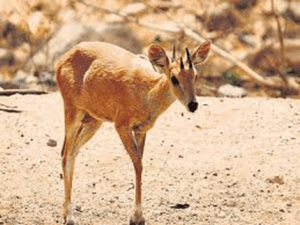TAG: GS 3: ECOLOGY AND ENVIRONMENT
THE CONTEXT: A rare four-horned antelope, also known as the Chousingha, has been sighted for the first time in the Veerangana Durgavati Tiger Reserve (formerly Nauradehi Sanctuary) located in Sagar district.
EXPLANATION:
- This significant discovery adds a new dimension to the biodiversity of the reserve, previously not known to harbor this vulnerable species.
- The field director of the reserve confirmed that the four-horned antelope was captured in a camera trap.
- This is the first recorded presence of this species in the dry region of Nauradehi, diverging from their typical habitats in moist areas such as Pench, Bandhavgarh, Kanha, and Sanjay Tiger Reserves.
Four-Horned Antelope
- The four-horned antelope (Tetracerus quadricornis), also called chousingha, is a small bovid antelope native to central, South and Western India, along with a smaller population in Nepal.
- The sole member of the genus Tetracerus, the chousingha was first described in 1816 by French zoologist Henri Marie Ducrotay de Blainville.
- Three regional subspecies are currently recognised. The four-horned antelope has a yellowish-tan, sometimes reddish or goldenrod coat.
- It is slender with thin legs and a short tail. It stands nearly 55–64 cm (22–25 in) at the shoulder and weighs about 17–22 kg (37–49 lb).
- Its four horns are unique among antelopes and distinguish it from most other bovids.
- The longer pair of straight, spike-like horns is atop its head between the ears, while the other, shorter pair is on the forehead; its posterior horns are always longer than the anterior horns, which may even present as merely fur-covered “studs”.
- While the posterior horns measure 8–12 cm (3.1–4.7 in), the anterior ones are usually 2–5 cm (0.79–1.97 in) long.
- Habitat and Adaptation
- The four-horned antelope usually inhabits wooded areas with abundant grass and proximity to water sources.
- Their presence in the drier region of Nauradehi suggests adaptability to different environmental conditions, indicating that they can thrive outside their known habitats.
- Distribution and Conservation Status
- The four-horned antelope is predominantly found in India and Nepal and is unique among bovids for its four horns, which are only present in males.
- Classified as ‘Vulnerable’ on the IUCN Red List, the species has an estimated population of 10,000, with the majority located in India.
- Conservation efforts are crucial to ensure the survival of this rare species.

Other Wildlife in Veerangana Durgavati Tiger Reserve
- In addition to the four-horned antelope, the camera traps also captured images of barking deer, another species that has brought excitement to forest officials.
- These sightings underscore the rich biodiversity of the reserve and its potential as a habitat for various wildlife species.
- The reserve has also successfully adapted two tigers relocated from the Bandhavgarh Tiger Reserve.
- These tigers have established territories and are thriving in their new environment, contributing to the reserve’s current population of 18 tigers, including cubs.
- This successful relocation is a testament to the reserve’s suitability for supporting large predators.
Implications for Conservation
- The sighting of the four-horned antelope and other species in the Veerangana Durgavati Tiger Reserve highlights the importance of continuous monitoring and conservation efforts.
- The ability of these species to adapt to new environments showcases the resilience of wildlife and the potential for expanding conservation habitats.
Veerangana Durgavati Tiger Reserve
- It is situated in the Madhya Pradesh state of India.
- It is located on an area of roughly 550 square kilometres and was founded in 1997.
- The reserve, which bears the legendary name of Queen Durgavati, is renowned for its abundant biodiversity.
- Numerous plant and animal species, such as the Indian leopard, Bengal tiger, and other types of deer, can be found in the reserve.
- It is an important habitat for a number of threatened species and contributes significantly to the preservation of wildlife.
- The Veerangana Durgavati Tiger Reserve provides chances for those who love animals and the natural environment to appreciate its splendour.

